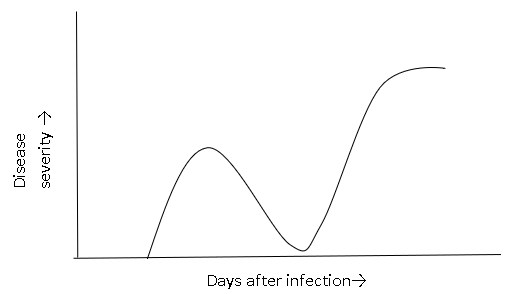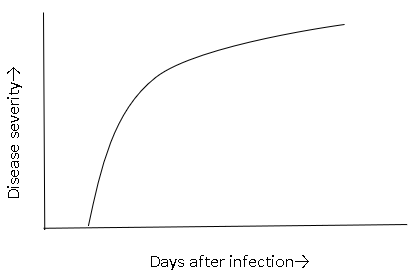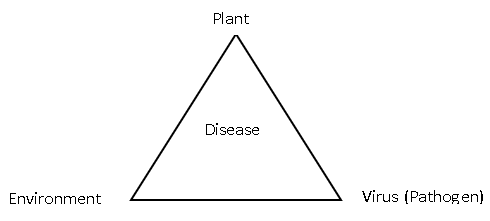This set of Virology Multiple Choice Questions & Answers (MCQs) focuses on “Control of Plant Viruses”.
1. How can we control nematode transmitted viral diseases of plants?
a) By cutting down the infected plants
b) By using bacteria-resistant plant varieties
c) By using antibiotics
d) By soil fumigation
View Answer
Explanation: Nematodes are present in the soil. They transmit viruses by feeding on roots of infected plants and then eating roots of healthy plants. Losses caused by nematode transmitted viruses can be reduced by soil fumigation to control the nematodes. Use of antibiotics and bacteria-resistant plants can only prevent bacterial infections.
2. Which of the following techniques is used to identify virus free plants?
a) ELISA
b) Ploidy level analysis
c) Microtomy
d) Anatomical studies
View Answer
Explanation: Enzyme linked immunosorbent assay (ELISA) technique is used to identify virus free plants. The mother plants, seeds and nursery stocks are tested for viruses by ELISA technique. It has helped greatly in reducing the frequency of viruses in the propagating stock of crop plants. This technique was developed in the late 1970s and is still used by plant pathologists to detect and study plant viruses.
3. In which of the following methods of plant disease control, the plants are inoculated with a mild strain of the virus?
a) Soil fumigation
b) Quarantine
c) Cross protection
d) Hereditary resistance
View Answer
Explanation: The disease caused by severe strains of the virus can be avoided if the plants are inoculated first with a mild strain of the same virus. This method protects the plant from infection by the severe strain of the virus. This process of controlling viral diseases of plants is called as cross protection.
4. Which of the following methods use genetic manipulation to give protection against plant viruses?
a) Pathogen-derived resistance
b) Application of pesticides
c) Soil fumigation
d) Use of virus free seeds
View Answer
Explanation: Many viruses are controlled to various extents through introduction of pathogen-derived resistance. This type of resistance is provided by introducing into plants the coat protein gene or some other segment of the genome of the virus. Such transgenic plants transcribe and express these genes, which interferes with the infection by the virus.
5. Some plant viruses can be inactivated by heat.
a) True
b) False
View Answer
Explanation: Some viruses can be inactivated by heat after they enter inside a plant. Dormant, propagative organs are dipped in hot water (35–54°C) for a few hours, whereas actively growing plants are kept in greenhouses or growth chambers at 35 to 40°C for several days. The virus is inactivated due to heat and the plants become completely healthy.
6. Which of the following hormones can be applied to control effects of virus infection of plants?
a) Ethylene
b) Abscisic acid
c) Gibberellic acid
d) Salicylic acid
View Answer
Explanation: Gibberellic acid is used for controlling virus diseases of plants in the field. Foliar application of this growth-regulating substance can overcome the dwarfing of plants induced by some viruses. It may also stimulate the growth of virus-suppressed axillary buds in virus infected trees.
7. Which type of disease-progress curve is represented in the below diagram?

a) Bimodal polycyclic
b) Monocyclic
c) Polycyclic
d) Bimodal monocyclic
View Answer
Explanation: Bimodal polycyclic disease-progress curve is being represented in the diagram. This curve represents the diseases which affect different organs (blossoms, fruit) of the plant. For example: The blossoms and the fruits are infected at different times in the brown rot disease of peaches. So, this disease shows a bimodal polycyclic disease-progress curve.
8. Which pattern of disease can be represented by the given curve?

a) Polycyclic
b) Bimodal polycyclic
c) Bimodal monocyclic
d) Monocyclic
View Answer
Explanation: This is a saturation-type curve. It represents the monocyclic diseases. Monocyclic diseases lack secondary inoculum. Therefore, secondary infections cannot occur during the same year. A sigmoid curve represents polycyclic diseases. Polycyclic diseases have several infection cycles during the same season.
9. What type of interaction between plant and virus is shown in the below diagram?

a) Disease progress curve
b) Disease gradient curve
c) Disease triangle
d) Disease cycle
View Answer
Explanation: The three main components of a plant virus disease are plant, virus (pathogen) and environment. For a plant disease to occur, these three components must come in contact and interact. The interactions of the three components of disease is visualized as a triangle known as the disease triangle. Each peak of the triangle represents one of the three components.
10. Which of the following areas can be used to produce seeds free from aphid-borne viruses?
a) Forests
b) High altitude fields
c) Plains
d) Deserts
View Answer
Explanation: To produce virus-free seeds the healthy plants should be grown in an area not suitable for vectors of the viruses. The aphids are absent or rare in high altitude fields. So, the crops are grown in high altitude regions and virus-free seeds are obtained from them.
11. Which of the following methods can be used to protect plants from viruses transmitted by aphids?
a) Quarantine
b) Polythene traps and mulches
c) Sanitation
d) Soil fumigation
View Answer
Explanation: Many plant viruses are brought into crops by airborne aphid vectors. Sticky, yellow polythene sheets can be hanged vertically along the sides of crops. The aphids get attracted to the plastic sheets and stick to it. Black polyethylene sheets can be used as mulches between the plants or rows of plants in the field. They repel the incoming aphids. Thus, plants can be protected from viruses transmitted by aphids.
12. Which of the following virus vectors can be prevented from infecting crops by using trap plants?
a) Aphids
b) Fungus
c) Dodder plant
d) Mites
View Answer
Explanation: Trap plants can be used to control aphid borne viruses. A few rows of rye, corn, or other tall plants are planted around a field of beans, peppers, or squash. The incoming aphids carrying viruses that attack the beans, peppers, and squash first stop and feed on the taller rows of rye or corn. Thus, many of the aphids lose the bean, pepper, or squash infecting viruses by the time they move onto these crops.
13. Which of the following chemicals can be used as soil fumigant?
a) Hydrochloric acid
b) Nitric acid
c) Chloropicrin
d) Chlorine
View Answer
Explanation: Chloropicrin is a broad-spectrum nematicide which is used as a soil fumigant. It is applied on soil before planting crops and covered with tarps. The soil fumigants can volatilize as they are applied to the soil or may decompose into gases in the soil. They are toxic to humans and animals, and should be handled with caution.
14. Cucumber mosaic virus can be controlled by which of the following methods?
a) Spraying oil
b) Spraying water
c) Spraying alcohol
d) Spraying acids
View Answer
Explanation: Cucumber mosaic virus is transmitted by aphids. When the plants are sprayed several times each season with a fine-grade mineral oil, it interferes with the ability of the aphid vector to transmit the virus. Such oil is not toxic to the aphids, but it prevents the transmission of aphid borne viruses.
15. Plants can be vaccinated against viruses.
a) True
b) False
View Answer
Explanation: Plants do not have an antibody- producing system like humans and animals. So, they cannot be immunized by vaccination. Inoculation of plants with certain pathogens often leads to immunization of the plants. This method induces plant resistance to a pathogen to which the plants are normally susceptible.
Sanfoundry Global Education & Learning Series – Virology.
To practice all areas of Virology, here is complete set of 1000+ Multiple Choice Questions and Answers.
If you find a mistake in question / option / answer, kindly take a screenshot and email to [email protected]
- Practice Biotechnology MCQs
- Check Biotechnology Books
- Check Virology Books
- Apply for Biotechnology Internship
